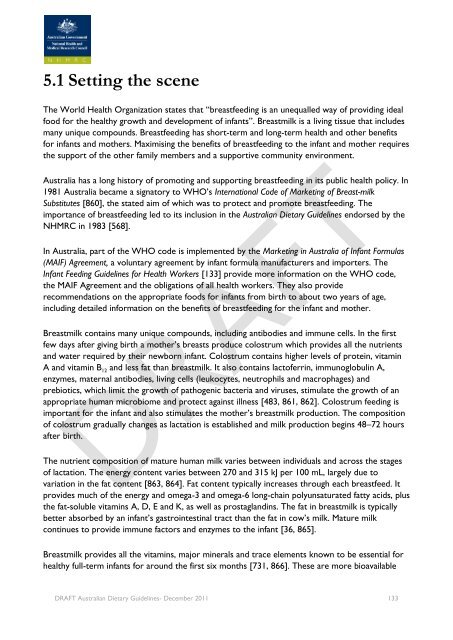DRAFT Australian Dietary Guidelines - Eat For Health
DRAFT Australian Dietary Guidelines - Eat For Health
DRAFT Australian Dietary Guidelines - Eat For Health
Create successful ePaper yourself
Turn your PDF publications into a flip-book with our unique Google optimized e-Paper software.
5.1 Setting the scene<br />
The World <strong>Health</strong> Organization states that “breastfeeding is an unequalled way of providing ideal<br />
food for the healthy growth and development of infants”. Breastmilk is a living tissue that includes<br />
many unique compounds. Breastfeeding has short-term and long-term health and other benefits<br />
for infants and mothers. Maximising the benefits of breastfeeding to the infant and mother requires<br />
the support of the other family members and a supportive community environment.<br />
Australia has a long history of promoting and supporting breastfeeding in its public health policy. In<br />
1981 Australia became a signatory to WHO’s International Code of Marketing of Breast-milk<br />
Substitutes [860], the stated aim of which was to protect and promote breastfeeding. The<br />
importance of breastfeeding led to its inclusion in the <strong>Australian</strong> <strong>Dietary</strong> <strong>Guidelines</strong> endorsed by the<br />
NHMRC in 1983 [568].<br />
In Australia, part of the WHO code is implemented by the Marketing in Australia of Infant <strong>For</strong>mulas<br />
(MAIF) Agreement, a voluntary agreement by infant formula manufacturers and importers. The<br />
Infant Feeding <strong>Guidelines</strong> for <strong>Health</strong> Workers [133] provide more information on the WHO code,<br />
the MAIF Agreement and the obligations of all health workers. They also provide<br />
recommendations on the appropriate foods for infants from birth to about two years of age,<br />
including detailed information on the benefits of breastfeeding for the infant and mother.<br />
Breastmilk contains many unique compounds, including antibodies and immune cells. In the first<br />
few days after giving birth a mother’s breasts produce colostrum which provides all the nutrients<br />
and water required by their newborn infant. Colostrum contains higher levels of protein, vitamin<br />
A and vitamin B 12 and less fat than breastmilk. It also contains lactoferrin, immunoglobulin A,<br />
enzymes, maternal antibodies, living cells (leukocytes, neutrophils and macrophages) and<br />
prebiotics, which limit the growth of pathogenic bacteria and viruses, stimulate the growth of an<br />
appropriate human microbiome and protect against illness [483, 861, 862]. Colostrum feeding is<br />
important for the infant and also stimulates the mother’s breastmilk production. The composition<br />
of colostrum gradually changes as lactation is established and milk production begins 48–72 hours<br />
after birth.<br />
The nutrient composition of mature human milk varies between individuals and across the stages<br />
of lactation. The energy content varies between 270 and 315 kJ per 100 mL, largely due to<br />
variation in the fat content [863, 864]. Fat content typically increases through each breastfeed. It<br />
provides much of the energy and omega-3 and omega-6 long-chain polyunsaturated fatty acids, plus<br />
the fat-soluble vitamins A, D, E and K, as well as prostaglandins. The fat in breastmilk is typically<br />
better absorbed by an infant’s gastrointestinal tract than the fat in cow’s milk. Mature milk<br />
continues to provide immune factors and enzymes to the infant [36, 865].<br />
Breastmilk provides all the vitamins, major minerals and trace elements known to be essential for<br />
healthy full-term infants for around the first six months [731, 866]. These are more bioavailable<br />
<strong>DRAFT</strong> <strong>Australian</strong> <strong>Dietary</strong> <strong>Guidelines</strong>- December 2011 133

















